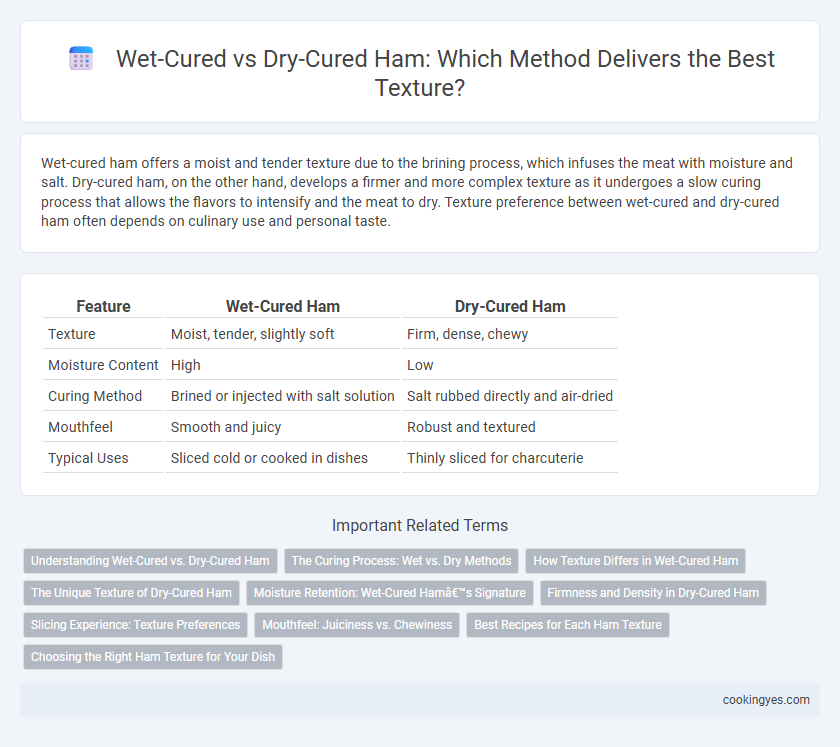Wet-cured ham offers a moist and tender texture due to the brining process, which infuses the meat with moisture and salt. Dry-cured ham, on the other hand, develops a firmer and more complex texture as it undergoes a slow curing process that allows the flavors to intensify and the meat to dry. Texture preference between wet-cured and dry-cured ham often depends on culinary use and personal taste.
Table of Comparison
| Feature | Wet-Cured Ham | Dry-Cured Ham |
|---|---|---|
| Texture | Moist, tender, slightly soft | Firm, dense, chewy |
| Moisture Content | High | Low |
| Curing Method | Brined or injected with salt solution | Salt rubbed directly and air-dried |
| Mouthfeel | Smooth and juicy | Robust and textured |
| Typical Uses | Sliced cold or cooked in dishes | Thinly sliced for charcuterie |
Understanding Wet-Cured vs. Dry-Cured Ham
Wet-cured ham is soaked in a brine solution, resulting in a moist, tender texture with a slightly salty taste, ideal for slicing and cooking. Dry-cured ham undergoes a slow curing process using salt and spices, producing a firmer, denser texture and a more concentrated, complex flavor profile. Understanding these differences helps select the right ham type for culinary applications, balancing moisture content and flavor intensity.
The Curing Process: Wet vs. Dry Methods
Wet-cured ham undergoes a brining process where the meat is soaked or injected with a solution of salt, sugar, and spices, resulting in a moist, tender texture due to higher water retention. Dry-cured ham is coated with a dry mixture of salt and seasonings, allowing moisture to gradually evaporate over weeks or months, producing a denser, firmer texture rich in concentrated flavors. The curing method directly affects the ham's texture and flavor intensity, with wet curing yielding a softer bite and dry curing offering a chewier, more robust profile.
How Texture Differs in Wet-Cured Ham
Wet-cured ham features a tender, moist texture due to the infusion of brine during the curing process, which allows salt and flavorings to penetrate deeply while retaining high moisture content. This method results in ham that is softer and more pliable compared to dry-cured varieties, with a smooth, succulent bite that melts easily in the mouth. The texture of wet-cured ham is often described as juicier and less dense, making it ideal for slicing thinly without crumbling.
The Unique Texture of Dry-Cured Ham
Dry-cured ham boasts a firm, dense texture with a slightly chewy bite, resulting from the slow removal of moisture over extended aging periods. This curing method enhances muscle fiber contraction and intensifies flavor concentration, creating a richer mouthfeel compared to wet-cured ham. The natural enzymatic and microbial activity during dry curing contributes to a complex, tender interior with characteristic marbling and a subtle, nutty finish.
Moisture Retention: Wet-Cured Ham’s Signature
Wet-cured ham stands out for its superior moisture retention due to the injection or soaking processes that infuse the meat with brine, resulting in a juicier and more tender texture. Dry-cured ham undergoes a slower, salt-driven dehydration, yielding a denser and firmer bite with concentrated flavors. Moisture retention in wet-cured ham enhances succulence, making it preferred for applications where a soft, moist texture is desired.
Firmness and Density in Dry-Cured Ham
Dry-cured ham is characterized by a firmer texture and higher density compared to wet-cured ham, resulting from prolonged salt curing and air-drying processes that remove moisture and concentrate proteins. The firmness of dry-cured ham offers a chewy, yet tender bite, appealing to consumers seeking a robust mouthfeel. In contrast, wet-cured ham retains more moisture, producing a softer and less dense texture due to brine injection and shorter aging periods.
Slicing Experience: Texture Preferences
Wet-cured ham offers a moist, tender texture that slices smoothly, making it ideal for delicate, thin cuts. Dry-cured ham features a firmer, denser texture with a slightly chewy consistency, providing a satisfying bite and enhanced flavor concentration. Texture preferences for slicing experiences depend on whether a smooth, easy-to-cut ham or a robust, flavorful chew is desired.
Mouthfeel: Juiciness vs. Chewiness
Wet-cured ham delivers a tender, juicy mouthfeel due to its higher moisture content retained during brining, creating a soft and succulent texture. Dry-cured ham, aged and air-dried without added liquid, offers a firmer, chewier bite with concentrated flavors and a dense, satisfying texture. The choice between wet-cured and dry-cured ham hinges on preference for either juicy softness or robust chewiness in mouthfeel.
Best Recipes for Each Ham Texture
Wet-cured ham offers a moist, tender texture perfect for slow-cooked recipes like glazed ham or hearty soups that benefit from its juiciness. Dry-cured ham, with its dense and firm texture, excels in thinly sliced preparations such as charcuterie boards, sandwiches, or salads, where its rich, intense flavor can shine. Selecting recipes tailored to these textures enhances the culinary experience, ensuring optimal taste and mouthfeel.
Choosing the Right Ham Texture for Your Dish
Wet-cured ham offers a moist, tender texture ideal for dishes requiring slicing or slow cooking, as the brine infusion retains juiciness. Dry-cured ham features a firmer, denser texture with concentrated flavors, perfect for charcuterie boards or recipes where a chewy bite enhances the dish. Selecting between wet-cured and dry-cured ham depends on the desired texture and cooking method to complement your culinary creation effectively.
Wet-cured vs Dry-cured ham for texture Infographic

 cookingyes.com
cookingyes.com